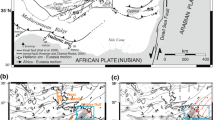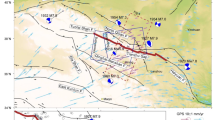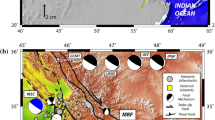Abstract
On August 24, October 26 and 30, 2016, Central Apennines (Italy) were hit by three shallow, normal faulting very strong earthquakes rupturing in an NW–SE striking zone. Event 3 (Norcia) occurred between event 1 (Amatrice) at the SE and event 2 (Visso) at the NW of the entire rupture zone. The rupture histories of the three events, as revealed by teleseismic P-wave inversion, showed that all were characterized by bilateral rupture process with stronger rupture directivity towards NW for events 1 and 3 and towards SSE for event 2. Maximum seismic slip of 1.2, 0.8, and 1.4 m in the hypocenter and magnitude of M w 6.2, 6.1, and 6.5 were calculated for the three events, respectively. DInSaR measurements based on Sentinel-1 and 2 satellite images showed ground deformation directivity from events 1 and 2 towards event 3, which is consistent with the rupture process directivity. For events 1, 2, and 3, the maximum ground subsidence was found equal to 0.2, 0.15, and 0.35 m. Based on rupture directivity and ground deformation pattern, we put forward the hypothesis that the area of the second event was stress loaded by the first one and that both the first and second earthquake events caused stress loading in the area, where the third event ruptured. Coulomb stress-transfer modelling yields strong evidence in favor of our hypothesis. The stress in the fault plane of event 2 was increased by ~0.19 bars due to loading from event 1. Event 3 fault plane was loaded by an amount of ~2 bars, due to the combined stress transfer from the two previous events, despite its proximity to the negative/positive lobe boundary. The three events produced combined stress loading of more than +0.5 bar along the Apennines to the NW and SE of the entire rupture zone. In the SE stress lobe, a series of strong earthquakes of M w 5.3, 5.6, and 5.7 occurred on January 18, 2017, but likely, seismic potential remains in the area. We consider that in the NW and more extensive stress lobe, the seismic potential has also elevated due to stress loading.










Similar content being viewed by others
References
Albano, M., Saroli, M., Moro, M., Falcucci, E., Gori, S., Stramondo, S., et al. (2016). Minor shallow gravitational component on the Mt. Vettore surface ruptures related to M w 6, 2016 Amatrice earthquake. Annals of Geophysics, 59, Fast Track 5, 1–6. doi:10.4401/ag-7299.
Avallone, A., Latorre, D., Serpelloni, E., Cavaliere, A., Herrero, A., Cecere, G., et al. (2016). Coseismic displacement waveforms for the 2016 August 24 M w 6.0 Amatrice earthquake (central Italy) carried out from high-rate GPS data. Annals of Geophysics, 59, Fast Track 5. doi:10.4401/ag-7275.
Basili, R., & Meghraoui, M. (2001). Coseismic and postseismic displacements related with 1997 earthquake sequence in Umbria–Marche (central Italy). Geophysical Research Letters, 28(14), 2695–2698.
Bignami, C., Tolomei, C., Pezzo, G., Guglielmino, F., Atzori, S., Trasatti, E., et al. (2016). Source identification for situational awareness of August 24th 2016 central Italy event. Annals of Geophysics, 59, Fast Track 5. doi:10.4401/AG-7233.
Boncori, J. P. M., Papoutsis, I., Pezzo, G., Tolomei, C., Atzori, S., Ganas, A., et al. (2015). The February 2014 Cephalonia earthquake (Greece): 3D deformation field and source modeling from multiple SAR techniques. Seismological Society of America, 86(1), 124–137. doi:10.1785/0220140126. (early edition).
Bonini, L., Maesano, F. E., Basili, R., Burrato, P., Cosimo Carafa, M. M., Fracassi, U., et al. (2016). Imaging the tectonic framework of the 24 August 2016, Amatrice (central Italy) earthquake sequence: New roles for old players? Annals of Geophysics, 59, Fast Track. doi:10.4401/ag-7229.
Cocco, M., Nostro, C., & Ekström, G. (2000). Static stress changes and fault interaction during the 1997 Umbria–Marche earthquake sequence. Journal of Seismology, 4, 501–516.
Costantini, M. (1998). A novel phase unwrapping method based on network programming. IEEE Transactions on Geoscience and Remote Sensing, 36(3), 813–821. doi:10.1109/36.673674.
D’Agostino, N., Giuliani, R., Mattone, M., & Bonci, L. (2001). Active crustal extension in the Central Apennines (Italy) inferred from GPS measurements in the interval 1994–1999. Geophysical Research Letters. doi:10.1029/2000GL012462.
Dalla Via, G., De Natale, G., Troise, C., Pingue, F., Obrizzo, F., Riva, R., et al. (2003). First evidence of post seismic deformation in the central Mediterranean: Crustal viscoelastic relaxation in the area of the 1980 Irpinia earthquake (Southern Italy). Geophysical Journal International, 154, F9–F14.
Falcucci, E., Gori, S., Galadini, F., Fubelli, G., Moro, M., & Saroli, M. (2016). Active faults in the epicentral and mesoseismal M L 6.0 August 24, 2016 Amatrice earthquake region, central Italy. Methodological and seismotectonic issues. Annals of Geophysics, 59, Fast Track 5. doi:10.4401/ag-7266.
Farr, T. G., & Kobrick, M. (2000). Shuttle radar topography mission produces a wealth of data. EOS Transactions of the American Geophysical Union, 81, 583–585.
Freed, A. M. (2005). Earthquake triggering by static, dynamic, and postseismic stress transfer. Annual Review of Earth and Planetary Sciences. doi:10.1146/annurev.earth.33.092203.122505.
Ganas, A., Chousianitis, K., Batsi, E., Kolligri, M., Agalos, A., Chouliaras, G., et al. (2013). The January 2010 Efpalion earthquakes (Gulf of Corinth, Central Greece): Earthquake interactions and blind normal faulting. Journal of Seismology, 17(2), 465–484.
Ganas, A., Gosar, A., & Drakatos, G. (2008). Static stress changes due to the 1998 and 2004 Krn Mountain (Slovenia) earthquakes and implications for future seismicity. Natural Hazards and Earth System Sciences, 8, 59–66.
Ganas, A., Grecu, B., Batsi, E., & Radulian, M. (2010). Vrancea slab earthquakes triggered by static stress transfer. Natural Hazards and Earth Systems Sciences, 10, 2565–2577.
Ganas, A., Roumelioti, Z., & Chousianitis, K. (2012). Static stress transfer from the May 20, 2012, M6.1 Emilia-Romagna (northern Italy) earthquake using a co-seismic slip distribution model. Annals of Geophysics, 55(4), 655–666.
Ganas, A., Roumelioti, Z., Karastathis, V., Chousianitis, K., Moshou, A., & Mouzakiotis, E. (2014). The Lemnos 8 January 2013 (M w = 5.7) earthquake: Fault slip, aftershock properties and static stress transfer modeling in the north Aegean Sea. Journal of Seismology, 18(3), 433–455.
Goldstein, R. M., & Werner, C. L. (1998). Radar interferogram filtering for geophysical applications. Geophysical Research Letters, 25(21), 4035–4038. doi:10.1029/1998GL900033.
Gomberg, J., Reasenberg, P. A., Bodin, P., & Harris, R. A. (2001). Earthquake triggering by seismic waves following the Landers and Hector mine earthquakes. Nature, 411, 462–466.
Hanks, T. C., & Kanamori, H. (1979). A moment magnitude scale. Journal of Geophysical Research, 84, 2348–2350.
Harris, R. A. (1998). Introduction to special section: Stress triggers, stress shadows, and implications for seismic hazard. Journal of Geophysical Research, 103, 24347–24358.
Harris, R. A., Simpson, R. W., & Reasenberg, P. A. (1995). Influence of static stress changes on earthquake locations in southern California. Nature, 375, 221–224.
Hartzell, S. H., & Heaton, T. H. (1983). Inversion of strong ground motion and teleseismic waveform data for the fault rupture history of the 1979 Imperial Valley, California, earthquake. Bulletin of the Seismological Society of America, 73, 1553–1583.
Hartzell, S. H., & Langer, Ch. (1993). Importance of model parameterization in finite fault inversions: Application to the 1974 M w 8.0 Peru earthquake. Journal of Geophysical Research, 98, 22123–22134.
Hartzell, S. H., Pengcheng, L., & Mendoza, C. (1996). The 1994 Northridge, California earthquake: Investigation of rupture velocity, rise time and high-frequency radiation. Journal of Geophysical Research, 101, 20091–20108.
Heaton, T. H. (1982). The 1971 San Fernando earthquake: A double event? Bulletin of the Seismological Society of America, 72, 2037–2062.
Herrmann, R. B., Malagnini, L., & Munafò, I. (2011). Regional moment tensors of the 2009 L’Aquila earthquake sequence. Bulletin of the Seismological Society of America, 101, 975–993.
Huang, M. -H., Fielding, E. J., Liang, C., Milillo, P., Bekaert, D., Dreger, D., & Salzer, J. (2017). Coseismic deformation and triggered landslides of the 2016 Mw 6.2 Amatrice earthquake in Italy. Geophysical Research Letters, 44, 1266–1274. doi:10.1002/2016GL071687.
Jacques, E., Monaco, C., Tapponnier, P., Tartorici, L., & Winter, T. (2001). Faulting and earthquake triggering during the 1783 Calabria seismic sequence. Geophysical Journal International, 147, 499–516.
Kilb, D., Gomberg, J., & Bodin, P. (2000). Triggering of earthquake aftershocks by dynamic stresses. Nature, 408, 570–574.
Langston, C. A., & Helmberger, D. V. (1975). A procedure for modeling shallow dislocation sources. Geophysics Journal of the Royal Astronomical Society, 42, 117–130.
Lanzano, G., Luzi, L., Pacor, F., Puglia, R., D’Amico, M., Felicetta, C., et al. (2016). Preliminary analysis of the accelerometric recordings of the August 24th, 2016 MW 6.0 Amatrice earthquake. Annals of Geophysics, 59, Fast Track 5. doi:10.4401/ag-7201.
Lavecchia, G., et al. (2016). Ground deformation and source geometry of the 24 August 2016 Amatrice earthquake (Central Italy) investigated through analytical and numerical modeling of DInSAR measurements and structural-geological data. Geophysical Research Letters, 43, 12389–12398. doi:10.1002/2016GL071723.
Louvari, E., & Kiratzi, A. (1997). Rake: A window’s program to plot earthquake focal mechanisms and stress orientation. Computers and Geosciences, 23, 851–857.
Marchetti, A., et al. (2016). The Italian Seismic Bulletin: Strategies, revised pickings and locations of the central Italy seismic sequence. Annals of Geophysics. doi:10.4401/ag-7169.
Mendoza, C., & Hartzell, S. (2013). Finite-Fault source inversion using teleseismic P waves: Simple parameterization and rapid analysis. Bulletin of the Seismological Society of America, 103, 834–844.
Murru, M., Taroni, M., Akinci, A., & Falcone, G. (2016). What is the impact of the August 24, 2016 Amatrice earthquake on the seismic hazard assessment in central Italy? Annals of Geophysics. doi:10.4401/AG-7209.
Okada, Y. (1992). Internal deformation due to shear and tensile faults in a half-space. Bulletin of the Seismological Society of America, 82, 1018–1040.
Pace, P., & Calamita, F. (2014). Push-up inversion structures vs. fault-bend reactivation anticlines along oblique thrust ramps: Examples from the Apennines fold-and-thrust belt (Italy). Journal of the Geological Society, 171, 227–238. doi:10.1144/0016-76492013-053.
Parsons, T., Ogata, Y., Zhuang, J., & Geist, E. L. (2012). Evaluation of static stress change forecasting with prospective and blind tests. Geophysical Journal International, 188, 1425–1440. doi:10.1111/j.1365-246X.2011.05343.x.
Parsons, T., Yeats, R. S., Yagi, Y., & Hussain, A. (2006). Static stress change from 8 October, 2005 M = 7.6 Kashmir earthquake. Geophysical Research Letters, 33, L06304. doi:10.1029/2005GL025429.
Perniola, B., Bressan, G., & Pondrelli, S. (2003). Changes in failure stress and stress transfer during the 1976–1977 Friuli earthquake sequence. Geophysical Journal International, 156, 297–306. doi:10.1111/j.1365-246X.2003.02146.x.
Pischiutta, M., Akinci, A., Malagnini, L., & Herrero, A. (2016). Characteristics of the Strong Ground Motion from the 24th August 2016 Amatrice Earthquake. Annals of Geophysics, 59, Fast Track 5. doi:10.4401/AG-7219.
Pondrelli, S., Salimbeni, S., & Perfetti, P. (2016). Moment tensor solutions for the Amatrice 2016 seismic sequence. Annals of Geophysics, 59, Fast Track 5. doi:10.4401/ag-7240.
Pucci, S., et al. (2016). Coseismic effects of the 2016 Amatrice seismic sequence: First geological results. Annals of Geophysics, 59, Fast Track 5, 1–8. doi:10.4401/AG-7195.
Reasenberg, P. A., & Simpson, R. W. (1992). Response of regional seismicity to the static stress change produced by Loma Prieta earthquake. Science, 255, 1687–1690.
Riva, R., Aoudia, A., Vermeersen, L. L. A., Sabadini, R., & Panza, G. F. (2000). Crustal versus asthenospheric relaxation and post-seismic deformation for shallow normal faulting earthquakes: The Umbria-Marche (central Italy) case. Geophysical Journal International, 141, F7–F11.
Roberts, G. P., & Michetti, A. M. (2004). Spatial and temporal variations in growth rates along active normal fault systems: An example from Lazio-Abruzzo, central Italy. Journal of Structural Geology, 26, 339–376.
Rovelli, A., & Calderoni, G. (2014). Stress drops of the 1997–1998 Colfiorito, Central Italy Earthquakes: Hints for a common behaviour of normal faults in the Apennines. Pure and Applied Geophysics, 171, 2731. doi:10.1007/s00024-014-0856-1.
Rovida, A., Locati, M., Camassi, R., Lolli, B., & Gasperini, P. (2016). CPTI15, the 2015 version of the Parametric Catalogue of Italian Earthquakes. Istituto Nazionale di Geofisica e Vulcanologia. doi:10.6092/INGV.IT-CPTI15.
Saccorotti, G., Piccinini, D., & Giunchi, C. (2016). Rupture imaging for the 2016 August 24, M w = 6.0 central Italy earthquake, from back projection of strong motion array data. Annals of Geophysics, 59, Fast Track 5. doi:10.4401/AG7294.
Scholz, C. H. (1968). Microfractures, aftershocks and seismicity. Bulletin of the Seismological Society of America, 58, 1117–1130.
Simpson R. W., & Reasenberg, P. A. (1994). Earthquake-induced static-stress changes on central California Faults. In: R. W. Simpson (Ed.), U.S. geological survey professional paper 1550-F “The Loma Prieta, California, Earthquake of October 17, 1989—Tectonic Processes and Models”, p 134.
Somerville, P., Irikura, K., Graves, R., Sawada, S., Wald, D., Abrahamson, N., et al. (1999). Characterizing crustal earthquake slip models for the prediction of strong ground motion. Seismological Research Letters, 70, 59–80.
Stein, R. S., Barka, A. A., & Dietrich, J. H. (1997). Progressive failure on the North Anatolian fault since by 1939 by earthquake stress triggering. Geophysical Journal International, 128, 594–604.
Stein, S., & Wysession, M. (2003). An introduction to seismology, earthquakes, and earth structure (p. 498). Oxford: Blackwell Publishers.
Tinti, E., Scognamiglio, L., Michelini, A., & Cocco, M. (2016). Slip heterogeneity and directivity of the M L 6.0, 2016, Amatrice earthquake estimated with rapid finite-fault inversion. Geophysical Research Letters. doi:10.1002/2016GL071263.
Toda, S., Stein, R. S., & Lin, J. (2011). Widespread seismicity excitation throughout central Japan following the 2011 M = 9.0 Tohoku earthquake and its interpretation by Coulomb stress transfer. Geophysical Research Letters, 38, L00G03. doi:10.1029/2011GL047834.
Toda, S., Stein, R. S., Reasenberg, P. A., & Dieterich, J. H. (1998). Stress transferred by the M w = 6.5 Kobe, Japan, shock: Effect on aftershocks and future earthquake probabilities. Journal of Geophysical Research, 103, 24543–24565.
Wells, D. L., & Coppersmith, K. J. (1994). New empirical relationships among magnitude, rupture length, rupture width, rupture area and surface displacement. Bulletin of the Seismological Society of America, 84(4), 974–1002.
Wessel, P., Smith, W. H. F., Scharroo, R., Luis, J. F., & Wobbe, F. (2013). Generic mapping tools: Improved version released. EOS Transactions of the American Geophysical Union, 94, 409–410.
Acknowledgements
This work was supported by the Center of Excellence BEYOND (“Building a Centre of Excellence for EO-based monitoring of Natural Disasters”), funded by the EU-FP7-REGPOT-2012-2013-1, G.A. 316210 project. This is also a contribution to the internal research project EARTHWARN of the Institute of Geodynamics, National Observatory of Athens (NOA). We acknowledge Bob Simpson for making available the DLC code. Ch. Kyriakopoulos, S. Valkaniotis, and Ch. Tsimi helped with Italian geophysical data. Thanks are due to Gian Maria Bocchini, PhD student at NOA, for useful discussions on the tectonics of Apennines. All illustrations were prepared using the GMT software (Wessel et al. 2013). We thank two anonymous reviewers for their constructive comments which helped to improve substantially the initial manuscript.
Author information
Authors and Affiliations
Corresponding author
Rights and permissions
About this article
Cite this article
Papadopoulos, G.A., Ganas, A., Agalos, A. et al. Earthquake Triggering Inferred from Rupture Histories, DInSAR Ground Deformation and Stress-Transfer Modelling: The Case of Central Italy During August 2016–January 2017. Pure Appl. Geophys. 174, 3689–3711 (2017). https://doi.org/10.1007/s00024-017-1609-8
Received:
Revised:
Accepted:
Published:
Issue Date:
DOI: https://doi.org/10.1007/s00024-017-1609-8







